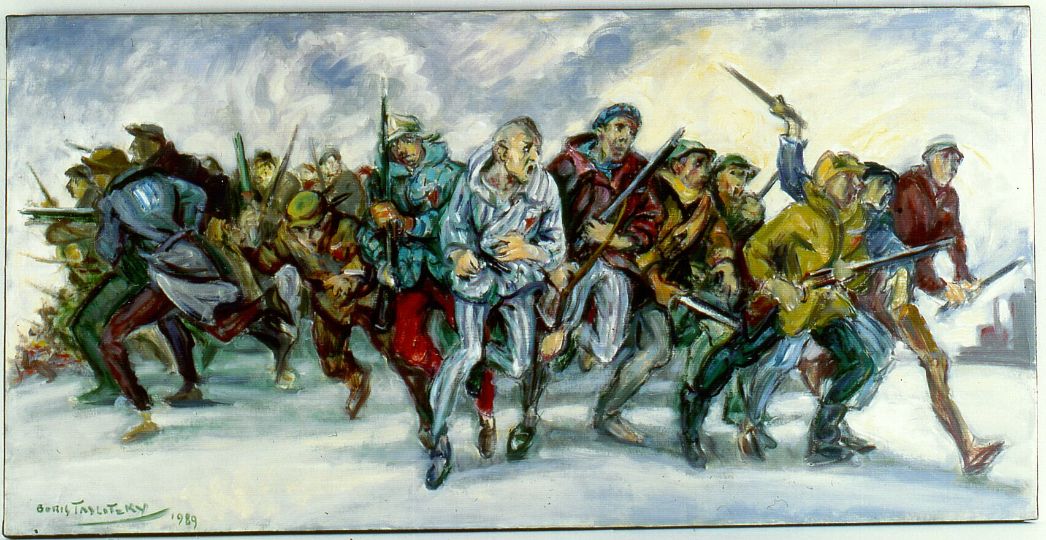
11 April 1945. There are 21,000 persons in the Buchenwald concentration camp, thousands of whom are enfeebled and close to death. Towards noon, the SS leave the camp and abscond towards the south. Units of the 3rd U.S. Army are approaching the Ettersberg. In the early afternoon, American tanks overrun the SS area and crush the last armed defence of the SS. At the same time, inmates of the camp resistance take control of the camp gate without a struggle and hoist a white flag. In a carefully prepared liberation operation, they break through the security facilities and occupy the watchtowers and the SS area. They capture 76 SS who have remained behind. Men of the French “Brigade d’Action Libératrice” are involved in these operations—among them the artist Boris Taslitzky.
These gripping events and the memory of the inmates’ resistance constitute the theme of the oil study le 11 avril 1945. The figures are running in three directions—not in confusion but deliberately, to occupy the different sections of the camp as planned. Yet Taslitzky did not endow them with the bearing of heroes. Instead, he depicted them in tattered clothing, marked by weakness, but plunging ahead with their last remaining strength. At the centre of the group, on wobbly legs, is a figure thought to represent Tastlitzky himself.
Biography
The artist Boris Taslitzky was born in Paris on 30 September 1911, the son of Russian Jews who had fled to France after the revolution of 1905. In 1928 he embarked on studies at the École Nationale des Beaux-Arts (National School of Fine Arts) and in 1933 joined the Association des Écrivains et Artistes Révolutionnaires (Association of Revolutionary Writers and Artists). In 1935 he became a member of the Communist party and drew for Ce Soir, a newspaper published from March 1937 onwards under the direction of Louis Aragon and Jean-Richard Bloch. As a member of the Maison de la Culture (House of Culture) association of painters and sculptors he organized exhibitions and discussions. It was in this phase that his lifelong friendship with the poet Louis Aragon began.
Taslitzky was called up for the infantry in August 1939 and soon taken prisoner by the Germans. He was able to escape but was captured once again in November 1941. He spent the following years in various place of detention until being deported to the Buchenwald concentration camp in August 1944. There he carried out “many rapid drawings and a few watercolours in the noise and cramped conditions of the block … with the feeling of being protected by the mass of human beings itself and the affectionate attention of the comrades surrounding me”.
After the war, in 1946, Louis Aragon initiated the publication of Taslitzky’s drawings in a volume of the Bibliothèque Française entitled 111 dessins faits à Buchenwald. Julien Cain, who had been a fellow inmate in Buchenwald and was now the director of the National Library in Paris, wrote the foreword. Taslitzky worked as a press artist, graphic artist, and painter. In 1971 he was appointed to the École Nationale Supérieure des Arts Décoratifs (National Higher School of Decorative Arts), where he taught for twelve years.
Taslitzky’s works were shown in many exhibitions, including one taking place in Berlin and Weimar in 1987/88. He cultivated close ties with the Buchenwald Memorial and in 1993 was on the jury for a Jewish monument in Buchenwald. In 1997, Boris Taslitzky was made “Chevalier de la Légion d’Honneur” (Knight of the Legion of Honour). He died in Paris on 9 December 2005.


